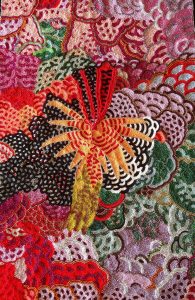Working the bead was a particularly widespread activity in South Africa and especially among the xhosa, a people originally from the Great Lakes region. This is an ancient tradition that allowed women to create ornamental objects, also intended to be used as important social markers. While it had almost fallen into oblivion, this craft was resurrected in an artistic form in 1999 because for the Ubuhle collective “true progress is a tradition that continues”. This is how the project of Ntombephi “Induna” Ntobela and Bev Gibson began, which offered local women the opportunity to revive this ancestral art of the province of KwaZulu Natal (Province of Natal) and to use their skills to achieve real financial autonomy.

Oshun Art – Zondlile-Zondo-African-Fire-2016-scaled
Going beyond the ornamental character, the artists of the Ubuhle collective use beads to create works of art, thanks to the technique of ndwango : it consists of stretching a black fabric to make a canvas support, then sewing a myriad of tiny beads to it in order to create often figurative and colorful scenes. Artists thus benefit from the variety of styles offered by their traditions. For example, the custom of xhosa favors neutral tones oscillating between pinks, blues and whites. As for Zulu women, they favor bright colors like Zondole Zondo, the only artist from this ethnic group. Requiring ten months of work on average, the works of art of the Ubuhle collective essentially narrate their spiritual beliefs, their daily environment but also their personal stories. This is how we can see the recurrence of the bovine figure which represents financial wealth, the tree which symbolizes spirituality, life as well as evolution, and more particularly in the work of Nonhlakanipho Mndiyatha, the desire of stability and security, through the presence of stylized houses. Furthermore, it is important to mention the ravages of HIV in South Africa, which caused the collective Ubuhle to lose five of its members. From 2006, the memory of the dead then became a major theme and a form of therapy: a way of mourning and paying homage.
Originally produced for the Anglican cathedral in Pietermaritzburg, “The African Crucifixion” is certainly the major work of art of the Ubuhle collective, dating from 2008. In addition to being particularly monumental (4.5 x 7.5 cm ), it represents a beautiful synthesis of the artistic characteristics of the group since it solicited the participation of seven artists. Composed of three scenes (the tree of destruction, the tree of sacrifice and the tree of life), “The African Crucifixion” features the emblematic biblical scene reinterpreted in a South African way and with contemporary issues. . Indeed, it illustrates how the resurrection occurs after a dark period and then of redemption. We find a black Christ in the center of the composition but also red ribbons (the sign of the fight against AIDS) in the scene on the left, reflecting the scourge which then affected the country. We also find recurring figures in the work of the Ubuhle collective, such as the house and a bull’s skull. Beyond the religious theme, the artists challenge the viewer to the difficulties experienced by South Africans, related to health, food, security and employment, while giving a glimmer of hope vis-à-vis live by their resolutions in the years to come.
The works of the Ubuhle collective are currently part of the permanent collections of numerous museums in the United States and South Africa and have been exhibited at the Smithsonian Institution.
Rama Barry
Sources
– The website of the Ubuhle collective:
– “Shimmering bead “paintings” by South African women on view at the Four Arts”
Jan Sjostrom, Palm Beach Daily News:
– “Ubuhle Art Collective: Dreams Are Like Water”, Contemporary And:
– “Come to my homeland Ubuhle and Astrid Dahl”, Galerie Bonne Espérance:
The Ubuhle Collective: Beads, Traditions and Sisterhood in South Africa | africultures
